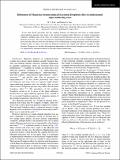| dc.contributor.author | Lee, Patrick A. | |
| dc.contributor.author | Law, Kam Tuen | |
| dc.date.accessioned | 2011-11-17T17:51:56Z | |
| dc.date.available | 2011-11-17T17:51:56Z | |
| dc.date.issued | 2011-08 | |
| dc.date.submitted | 2011-07 | |
| dc.identifier.issn | 1098-0121 | |
| dc.identifier.issn | 1550-235X | |
| dc.identifier.uri | http://hdl.handle.net/1721.1/67049 | |
| dc.description.abstract | It has been shown previously that the coupling between two Majorana end states in single-channel superconducting quantum wires leads to the fractional Josephson effect. However, in realistic experimental conditions, multiple bands of the wires are occupied and the Majorana end states are accompanied by other fermionic end states. This raises the question concerning the robustness of the fractional Josephson effect in these situations. Here we show that the absence of the avoided energy crossing which gives rise to the fractional Josephson effect is robust, even when the Majorana fermions are coupled with arbitrary strengths to other fermions. Moreover, we calculate the temperature dependence of the fractional Josephson current and show that it is suppressed by thermal excitations to the other fermion bound states. | en_US |
| dc.description.sponsorship | Croucher Foundation | en_US |
| dc.description.sponsorship | United States. Dept. of Energy (Grant No. DE-F602-03ER46076) | en_US |
| dc.language.iso | en_US | |
| dc.publisher | American Physical Society | en_US |
| dc.relation.isversionof | http://dx.doi.org/10.1103/PhysRevB.84.081304 | en_US |
| dc.rights | Article is made available in accordance with the publisher's policy and may be subject to US copyright law. Please refer to the publisher's site for terms of use. | en_US |
| dc.source | APS | en_US |
| dc.title | Robustness of Majorana fermion induced fractional Josephson effect in multichannel superconducting wires | en_US |
| dc.type | Article | en_US |
| dc.identifier.citation | Law, K., and Patrick Lee. “Robustness of Majorana fermion induced fractional Josephson effect in multichannel superconducting wires.” Physical Review B 84 (2011): n. pag. Web. 17 Nov. 2011. © 2011 American Physical Society | en_US |
| dc.contributor.department | Massachusetts Institute of Technology. Department of Physics | en_US |
| dc.contributor.approver | Lee, Patrick A. | |
| dc.contributor.mitauthor | Lee, Patrick A. | |
| dc.contributor.mitauthor | Law, Kam Tuen | |
| dc.relation.journal | Physical Review B | en_US |
| dc.eprint.version | Final published version | en_US |
| dc.type.uri | http://purl.org/eprint/type/JournalArticle | en_US |
| eprint.status | http://purl.org/eprint/status/PeerReviewed | en_US |
| dspace.orderedauthors | Law, K.; Lee, Patrick | en |
| dc.identifier.orcid | https://orcid.org/0000-0001-7809-8157 | |
| mit.license | PUBLISHER_POLICY | en_US |
| mit.metadata.status | Complete | |
